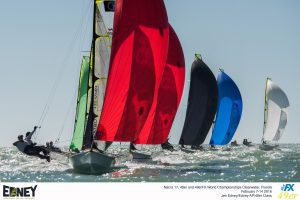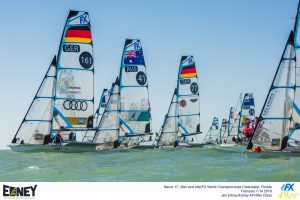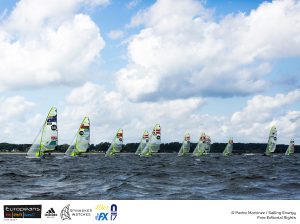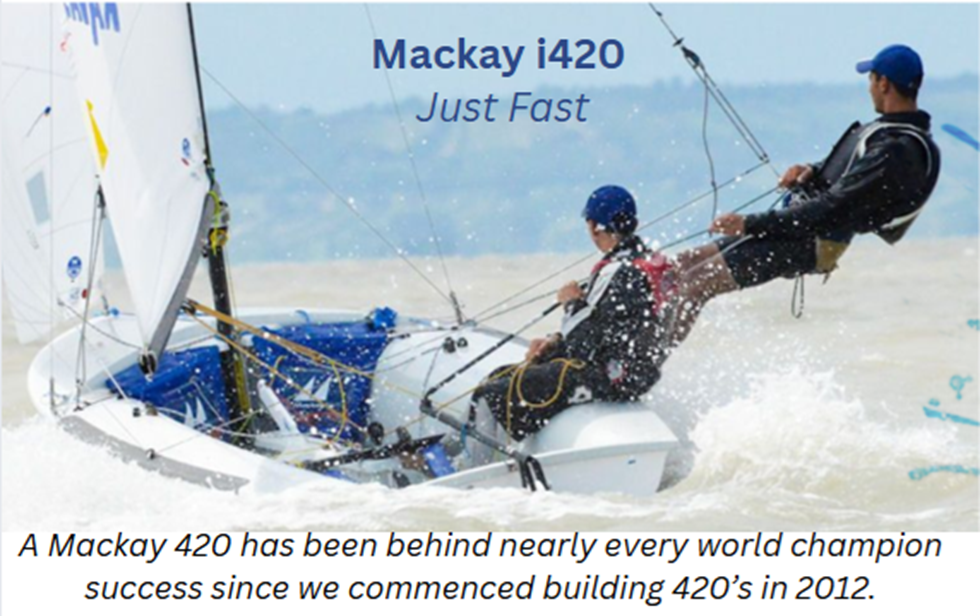In 1996 the 49er was chosen to be the twin trapeze skiff choice for Olympic sailing. It was designed by Julian Bethwaite and is an evolution of the International 14’s and 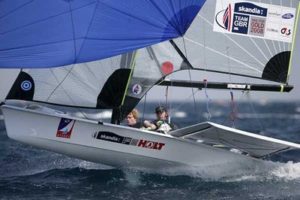
The History
The 49ers history starts back in 1996 where top sailors from around the world traveled to Lake Garda for a trial of different classes to see which would be the new twin-trapeze skiff for the 2000 Olympics in Sydney. The 49er proved to be the favorite for the sailors, and by November 1996 it was named the new Olympic skiff. Once named the Olympic skiff the production for the 49er was in high demand, with a waiting list developing within a matter of days after the Olympic announcement. Boat builders around the world worked hard to fill the demand. Two of the major boat builders that helped to grow 49er class are Ovington Boats based in England and Mackay Boats in New Zealand. The European Championships in Weymouth was the first international regatta held in September 1997. A total of 80 boats were already competing only a year after being announced as the new Olympic skiff. Since its launch in 1996, the 49er has been an instant hit and has evolved into the favorite skiff boat around the world.
The Boat
The name of the 49er comes from its hull length in meters, which is 4.99. Julian Bethwaite designed it, and it incorporates ideas from his design of the Aussie 18. The 49er is easy to handle and is controllable in conditions over 20 knots. Build out of fiberglass and carbon fiber the 49er is strong and light, weighing in at 275 pounds when fully rigged. As with any boat, the construction has gone through some changes through the years. In 2009 Mackay Boats build the new class molds which are now used by all builders worldwide. Also during this time, other improvements were made including a significant upgrade to the wings which are now pinned in place instead of sitting on sliding tracks. The wings are 9 feet wide with allows the crew to have maximum leverage. The sail area is 639 square feet which makes this small boat very fast! The vang uses a “ram vang” system; this system benefits the boat in three ways. First, it is a safer system because it pushes the boom down from above rather than pulling it down from below, which holds the mid-mast forward and prevents it from inverting when under pressure from the spinnaker. Second, it leaves the front cockpit open which allows for the crew to move more freely and efficiently across the boat. Thirdly, it brings the mainsail working area down to the deck level which helps reduce the drag. These boats are built for speed with top speeds over 20 knots, which makes it essential for the skipper and crew to work together to avoid any mistakes which can lead to capsizing. To be competitive on the water 49er sailors need to be reactive and quick-thinkers.
49erFX
The 49er introduced a new exciting form of sailing to the world. Mackay Boats in New Zealand found a way for more sailors to get involved and developed a smaller rig that fit into the 49er, the 49erFX. They trialed the 49erFX against several other boats, and it was selected to be used for the 2016 Olympics in Brazil. The 49erFX has made the experience of the 49er available to top women sailors. The FX uses a main with a wider head and only five battens, with the wider head a stiffer mast is needed to keep the boat in control through different wind conditions. The FX sail design makes it so that it can compete with the 49er in most upwind and downwind conditions. Two differences sailors notice the most between the 49er and FX is the rig depowers the boat, making it more easy to handle in winds 20-25 knots. Another positive difference is the performance downwind; the FX more easily bears away as the spinnaker is much flatter and flies further off the boat. Also, the bow lifts more out of the water which means sailors can go through waves without nosediving as they would in the 49er. This skiff requires sailors to be on top of their game with their skills, balance, and be in top shape. The 49erFX is a thrilling skiff that has paved the way for women sailors to compete in a high- performance boat and has shown the world that women sailors are amazing athletes!
For more info on the class go to www.49er.org
Click here for a video about the 49er.
Click here for a video about the 49erFX.
49er sailing
A Monumental Step Forward for the 49er Class
By Clinton Hayes
A Monumental Step Forward for the 49er Class
While clicking through the usual sailing media outlets, I came across something this week that deserves some more attention. In what I see as a truly revolutionary step,the 49er class has announced that they are moving forward with their “theater style” racing for the Rio 2016 Olympics and beyond. The real revolutionary part is not necessarily the format itself, but the philosophical stance they have taken by “proposing an alternative format to better align Olympic sailing with the Olympic business model.”
Large Country flags have been a staple in 49er sailing for a long time and are now required in all competition.
If you’re not familiar with it, theater style racing is the 49er class’s finals format. It involves 3 single point races with the top 10 boats from the qualifying series, no drops, with points from qualifying carrying through to the end. The big difference is it’s sailed on an actual racetrack, 600 meters by 325 meters maximum with boundaries that can’t be crossed. The class settled on this after multiple tests, and the decision to move in this direction after the single medal race format, run in the Olympics since 2008, turned out to be less than compelling for main stream media and not fulfilling for the sailors.
Theater Style Finals course (ignore MS and MP). The boundaries are actually a line of buoys on the same string so there’s no confusion. As this concept advances they will find even better ways to mark the racetrack.
If you haven’t seen one of these theater style races, they really are worth watching. Check out these from the Miami World Cup. https://www.youtube.com/playlist?list=PL0qme8rhNJgfECErZy_bylLNncaT4P8Tu
For the first time ever you can watch a sailboat race from beginning to end and understand who won and how they got there. The races are about 12 minutes long and full of action, beginning to end. I would go out on a limb and even say its more exciting than watching match racing, which I really enjoy. It’s important to note that the video from Miami is a very amateur production, yet, unlike most live racing video, its still fun to watch. Think of where it could go with a full budget. Sailing could actually fit in the space between commercials in a normal Olympic (or any other TV) broadcast. You could explain to the public HOW someone won a race in more detail than just, “they caught a wind shift and went faster.”
Generally, changes like this are interpreted as some sort of a tradeoff. As Scuttlebutt wrote, “Sport vs Spectator…will the reward be worth the change?” Although I get where they are coming from, this is flawed old school thinking. How are theater style races worse for the sport? I only hear people talk about the 2 hour long Olympic races of years past with a glazed over look in their eyes. Sure, this racing requires a different, more tactical skill set but like always the boat that sails the best will win. If, on the off chance, a boat sails so well in the qualifying series that they are well ahead of the fleet, then they might only have to score mid fleet results in the finals to clinch the regatta win. In terms of spectator, is it better for sailing to move towards a golfing image or a more extreme Red Bull Media image? I could go on but the 49er class explains it best: http://49er.org/blog/classinfonews/the-49er-progression-drive-explained/
Some questions do linger such as, “what do the sailors actually think?” This will only be answered with time but given the direction high performance sailing is headed (think extreme 40s and the Cup) coupled with the fact that many of the pros are 49er sailors, they won’t (and really shouldn’t) be against it. Top Olympic athletes survive off marketing dollars and anything that generates more views directly correlates to sponsorship potential. Sure it will be stressful and sure, the team who loses the Gold because of an unlucky break will be frustrated, but that’s sport. Unlucky breaks are common and those who truly love sport will come back time after time, not because of the race they won, but because of the Gold they lost on that unlucky break.
